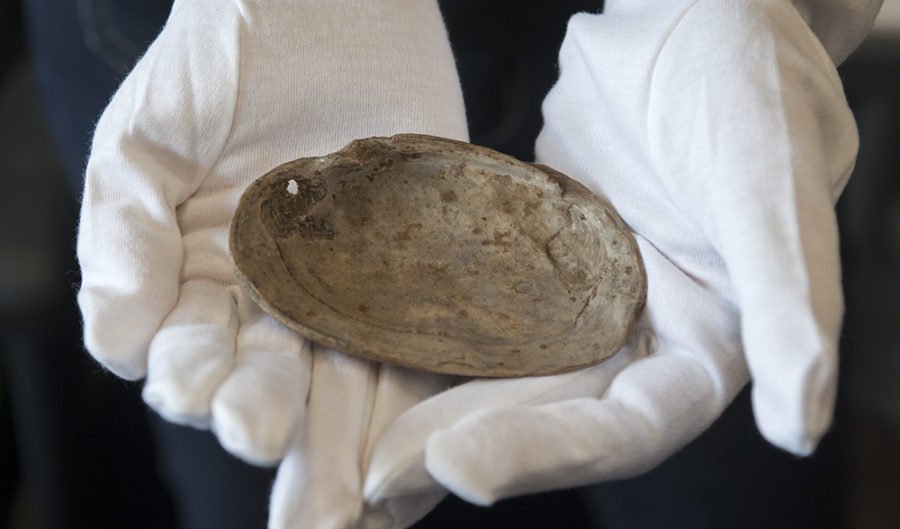World’s oldest engraving discovered

A ROUTINE PROJECT to catalogue museum specimens has resulted in a true ‘eureka’ moment for scientists, who say they’ve uncovered the oldest-known engraving in the world.
The chiselled shell, dating back between 540,000 and 430,000 years, was among the iconic fossil collection established in the 19th century by Eugène Dubois, at Trinil, in Java, Indonesia, where he discovered the first Homo erectus.
The discovery was made by chance among hundreds of images shells, photographed to determine if they belonged to a natural or man-made assemblage, says Dr Stephen Munro, a biological anthropologist from Australian National University, and curator at the National Museum of Australia, who co-authored the report, published today in Nature.
“When I got to image number 298 I almost fell off my chair. It was one of those eureka moments where I thought, ‘this really does have the potential to rewrite what we know about human evolution’,” he says.
Engraved shell could rewrite human evolution
The freshwater mollusc shells fossils, found in the same area and dated to around same time that Homo erectus lived, had geometric patterns etched into them, such as zigzag grooves, and holes in the precise location that would be easiest to open the shell.
Scientists also identified a polished shell that had been modified as a tool for cutting or scrapping.
The fossil are at least 300,000 years older than the previously confirmed oldest engravings, created by modern humans, Homo sapiens, in the Klasies River Caves of Eastern Cape Province, South Africa.
Such engravings have, so far, only been known for our species, but this find raises the possibility that our primitive cousin, Homo erectus may have had modern cognitive abilities.
The scientists, though, are cautious of this interpretation.
“The find simply shows that half a million years ago, Homo erectus was capable of producing a puzzling zigzag pattern,” says Dr Wil Roebroeks, an archaeologist from Leiden University in The Netherlands and co-author of the report. “This is just one piece, but the fact that hundreds of thousands of years ago some hominins were capable of producing this zigzag probably means that in due time, more such finds will turn up.”
Australasia: a cradle of human evolution?
The current findings add to recent discoveries that point towards the Australasian region playing an important part in our understanding of human evolution.
In 2003, scientists discovered a new human species in Flores Island and, more recently, some of the world’s oldest cave art was found in a cave of Sulawesi, both sites in Indonesia.
“All these finds necessitate a re-assessment of global processes of human evolution and they emphasise the importance of systematic archaeological research and fieldwork in all parts of the world, to overcome the historical biases that have traditionally favoured Europe,” says Dr. Martin Porr, an archaeologist from the University of Western Australia in Perth.
Significance of fossil shell patterns
Not all scientists feel as excited with the new findings, as the simplicity of the patterns raises the questions about its true significance, says Dr Richard Klein, an anthropology professor from Stanford University in the USA.
“Pattern means pattern, whether in everyday life or in archaeology, and I don’t see one on the shell. I don’t think expertise is involved, just wishful thinking,” he says.
The scientists who made the discovery say their research stands strong. “A lot of painstaking analyses went into the study of what processes might have created the pattern: in the first place, of course non-anthropogenic ones, as meticulously analysed by Dr Francesco d’Errico”, says co-author Wil.
And they are quick to quality that “Nobody knows its true significance,” says Wil. “We agree completely that it is a very simple zigzag – but it is a human-made one.”




